Kim Bridges: Projects Website

Extreme Size: Honolulu Harbor
The Procedure
Step 1: Fifty images were taken on a tripod and panoramic head using a Sony a7R4 camera with a Sony 135mm f/1.4 lens. The tripod was leveled and the camera was pointed for each of the photos with just a general reference to the pan head scale markings. Three rows of photos were taken.Step 2: The raw images were imported to Adobe Photoshop and adjusted using the "auto" setting. These exposure-adjusted images were saved as JPG files.
Step 3: PTGui (version 12-4 beta) was used to stitch the images. The perspective was set to equirectilinear and a small amount of cropping was done, primarily to the sides of the stitched image.
This panoramic image spans 149.7 x 49.9 degrees.
Upon saving the stitched image, a warning message appeared in PTGui saying that the maximum number of pixels for a JPG image is 65,000. This stitched image is 81,718 x 15,985 pixels. That's a 1.306 gigapixel image.
The width was adjusted in PTGui to 79%. This reduced the dimensions to 64,557 x 12,628 pixels.
Step 4: This reduced-size image was taken back into Photoshop and the Topaz Labs SharpenAI filter was applied using the focus setting (with slightly less sharpening than the value recommended in the auto setting). The filter processing required two hours to process. A JPG file was saved with a file size of 135,714 KB.
Step 5: The final step was the use of Zoomify's converter to create a ZIF file. This took only a few seconds. The resulting ZIF file is 244,674 KB (1.8 times larger than the JPG file).
The Panorama
The Analysis
An obvious defect in this panoramic image is the cutting off of the tops of a few tall buildings. That wasn't intentional and it was discovered only after the photos were well into the processing steps. This scene will be re-photographed as soon as some of the typical fluffy clouds reappear in the western sky.Even with the clipped-building defect, this panorama functions well as a test of a very large panorama. We are now aware of the 65K pixel limitation.
Photography using a tripod violates the spirit of the "run and gun" strategy that has come to be very useful in taking panoramic images. In this case, with the need to three (or, better, four) rows of images, use of the tripod was handy. In this case, it was easily available.
This mega-panorama used a Sony 135 mm telephoto lens. This is not a long telephoto lens, but it is a big contrast with the more usual Sony 24mm lens used in most of the other recent panoramas. This is a very sharp lens. Even though a shutter release was used, there may have been a tiny bit of camera shake. This would "soften" the images. Also, the down-scaling in PTGui that was used to fit the image into the size constraint could have further "softened" the overall image. Using Topaz Lab's SharpenAI filter improved the final image.